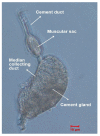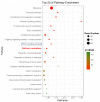Insights into the Synthesis, Secretion and Curing of Barnacle Cyprid Adhesive via Transcriptomic and Proteomic Analyses of the Cement Gland
- PMID: 32244485
- PMCID: PMC7230167
- DOI: 10.3390/md18040186
Insights into the Synthesis, Secretion and Curing of Barnacle Cyprid Adhesive via Transcriptomic and Proteomic Analyses of the Cement Gland
Abstract
Barnacles represent one of the model organisms used for antifouling research, however, knowledge regarding the molecular mechanisms underlying barnacle cyprid cementation is relatively scarce. Here, RNA-seq was used to obtain the transcriptomes of the cement glands where adhesive is generated and the remaining carcasses of Megabalanus volcano cyprids. Comparative transcriptomic analysis identified 9060 differentially expressed genes, with 4383 upregulated in the cement glands. Four cement proteins, named Mvcp113k, Mvcp130k, Mvcp52k and Mvlcp1-122k, were detected in the cement glands. The salivary secretion pathway was significantly enriched in the Kyoto Encyclopedia of Genes and Genomes (KEGG) enrichment analysis of the differentially expressed genes, implying that the secretion of cyprid adhesive might be analogous to that of saliva. Lysyl oxidase had a higher expression level in the cement glands and was speculated to function in the curing of cyprid adhesive. Furthermore, the KEGG enrichment analysis of the 352 proteins identified in the cement gland proteome partially confirmed the comparative transcriptomic results. These results present insights into the molecular mechanisms underlying the synthesis, secretion and curing of barnacle cyprid adhesive and provide potential molecular targets for the development of environmentally friendly antifouling compounds.
Keywords: barnacle; cement gland; cement protein; cyprid adhesive; transcriptome.
Conflict of interest statement
The authors declare no conflicts of interest.
Figures







Similar articles
-
In Vitro Oxidative Crosslinking of Recombinant Barnacle Cyprid Cement Gland Proteins.Mar Biotechnol (NY). 2021 Dec;23(6):928-942. doi: 10.1007/s10126-021-10076-x. Epub 2021 Oct 29. Mar Biotechnol (NY). 2021. PMID: 34714445 Free PMC article.
-
Comparative Analysis of the Adhesive Proteins of the Adult Stalked Goose Barnacle Pollicipes pollicipes (Cirripedia: Pedunculata).Mar Biotechnol (NY). 2019 Feb;21(1):38-51. doi: 10.1007/s10126-018-9856-y. Epub 2018 Nov 10. Mar Biotechnol (NY). 2019. PMID: 30413912
-
iTRAQ-based proteomic profiling of the barnacle Balanus amphitrite in response to the antifouling compound meleagrin.J Proteome Res. 2013 May 3;12(5):2090-100. doi: 10.1021/pr301083e. Epub 2013 Apr 24. J Proteome Res. 2013. PMID: 23540395
-
Biomineralization in Barnacle Base Plate in Association with Adhesive Cement Protein.ACS Appl Bio Mater. 2023 Sep 18;6(9):3423-3432. doi: 10.1021/acsabm.3c00117. Epub 2023 Apr 20. ACS Appl Bio Mater. 2023. PMID: 37078387 Review.
-
Tick attachment cement - reviewing the mysteries of a biological skin plug system.Biol Rev Camb Philos Soc. 2018 May;93(2):1056-1076. doi: 10.1111/brv.12384. Epub 2017 Nov 8. Biol Rev Camb Philos Soc. 2018. PMID: 29119723 Free PMC article. Review.
Cited by
-
Barnacle inspired high-strength hydrogel for adhesive.Front Bioeng Biotechnol. 2023 Apr 3;11:1183799. doi: 10.3389/fbioe.2023.1183799. eCollection 2023. Front Bioeng Biotechnol. 2023. PMID: 37077234 Free PMC article.
-
Bioactive Peptides from Barnacles and Their Potential for Antifouling Development.Mar Drugs. 2023 Aug 30;21(9):480. doi: 10.3390/md21090480. Mar Drugs. 2023. PMID: 37755093 Free PMC article. Review.
-
In Vitro Oxidative Crosslinking of Recombinant Barnacle Cyprid Cement Gland Proteins.Mar Biotechnol (NY). 2021 Dec;23(6):928-942. doi: 10.1007/s10126-021-10076-x. Epub 2021 Oct 29. Mar Biotechnol (NY). 2021. PMID: 34714445 Free PMC article.
-
Adhesive Materials Inspired by Barnacle Underwater Adhesion: Biological Principles and Biomimetic Designs.Front Bioeng Biotechnol. 2022 Apr 25;10:870445. doi: 10.3389/fbioe.2022.870445. eCollection 2022. Front Bioeng Biotechnol. 2022. PMID: 35573228 Free PMC article. Review.
-
Decoding the byssus fabrication by spatiotemporal secretome analysis of scallop foot.Comput Struct Biotechnol J. 2022 May 27;20:2713-2722. doi: 10.1016/j.csbj.2022.05.048. eCollection 2022. Comput Struct Biotechnol J. 2022. PMID: 35685371 Free PMC article.
References
-
- Walker G. The Biochemical Composition of the Cement of two Barnacle Species, Balanus Hameri and Balanus Crenatus. J. Mar. Biol. Assoc. U. K. 1972;52:429–435. doi: 10.1017/S0025315400018786. - DOI
-
- Kamino K. Barnacle Underwater Attachment. In: Smith A.M., editor. Biological Adhesives. Springer International Publishing; Cham, Switzerland: 2016. pp. 153–176. - DOI
MeSH terms
Substances
Grants and funding
LinkOut - more resources
Full Text Sources
Molecular Biology Databases

